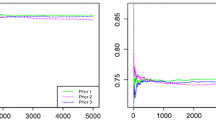Abstract
In terms of stochastic orders, the purpose of this paper is to show how the random environment can affect the number of working components of a system with heterogeneous components sharing a common random environment. Applications to a class of semiparametric mixture models, stress-strength model and warm standby system are presented.
Similar content being viewed by others
References
Al-Mutairi D, Agarwal S (1997) Distributions of the lifetimes of system components operating under an unknown common environment. J Appl Stat 24:85–96
Belzunce F, Mercader J-A, Ruiz J-M, Spizzichino F (2009) Stochastic comparisons of multivariate mixture models. J Multivar Anal 100:1657–1669
Bennett S (1983) Analysis of survival data by the proportional odds model. Stat Med 2:273–277
Cox DR (1972) Regression models and life tables (with discussion). J R Stat Soc Ser B 34:187–220
Eryılmaz S (2011a) A new perspective to stress-strength models. Ann Inst Stat Math 63:101–115
Eryılmaz S (2011b) The behavior of warm standby components with respect to a coherent system. Stat Probab Lett 81:1319–1325
Gupta RC, Gupta RD (2007) Proportional reversed hazard rate model and its applications. J Stat Plan Inf 137:3525–3536
Jaisingh LR, Dey DK, Griffith WS (1993) Properties of a multivariate survival distribution generated by a Weibull and inverse-Gaussian mixture. IEEE Trans Reliab 42:618–622
Karlin S (1968) Total Positivity. Stanford University Press, Stanford
Kochar S, Mukerjee H, Samaniego FJ (1999) The “signature” of a coherent system and its application comparison among systems. Nav Res Logist 46:507–523
Kotz S, Lumelskii Y, Pensky M (2003) The stress-stength model and its generalizations. World Scientific, Singapore
Lefèvre C, Malice MP (1989) On a system of components with joint lifetimes distributed as a mixture of independent exponential laws. J Appl Probab 26:202–208
Lindley DV, Singpurwalla ND (1986) Multivariate distributions for the life lengths of components of a system sharing a common environment. J Appl Probab 23:418–431
Ling X, Zhao P, Li X (2012) On a system of nonhomogeneous components sharing a common frailty. J Stat Plan Inf 142:1330–1338
Ma C (1999) Uniform stochastic ordering on a system of components with dependent lifetimes induced by a common environment. Sankhyā Indian J Stat Ser A 61:218–228
Müller A, Stoyan D (2002) Comparison methods for stochastic models and risks. Wiley, New York
Nayak TK (1987) Multivariate lomax distribution: properties and usefulness in reliability theory. J Appl Probab 24:170–177
Samuels SM (1965) On the number of successes in independent trials. Ann Math Stat 36:1272–1278
Samaniego FJ (1985) On the closure of the IFR class under formation of coherent systems. IEEE Trans Reliab R–34:69–72
Shaked M, Shanthikumar JG (2007) Stochastic orders. Springer, New York
Whitmore GA, Lee M-LT (1991) A multivariate survival distribution generated by an inverse Gaussian mixture of exponentials. Technometrics 33:39–50
Acknowledgments
This work was supported by the Scientific Research Foundation of Hebei University of Science and Technology (XL201256) for the first author, and by National Natural Science Foundation of China (71231001) for the second author.
Author information
Authors and Affiliations
Corresponding author
Rights and permissions
About this article
Cite this article
Ling, X., Li, P. Stochastic comparisons for the number of working components of a system in random environment. Metrika 76, 1017–1030 (2013). https://doi.org/10.1007/s00184-012-0429-1
Received:
Published:
Issue Date:
DOI: https://doi.org/10.1007/s00184-012-0429-1




